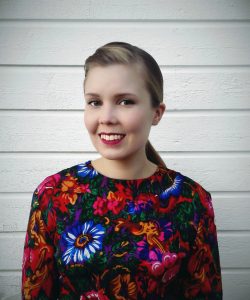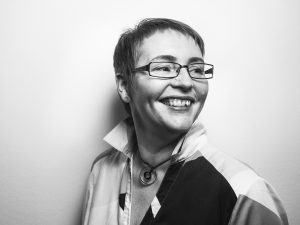Together with textile designer Rosa Tolnov Clausen, Martin Born is curating the HIAP design residency programme in Helsinki. In May, Martin will moderate a panel discussion at Design Museum, where this year’s designers-in-residence, Laura Spring (UK) and Elina Laitinen (FI), will discuss their practices. Design Museum met Martin and asked him more about the HIAP design residency programme and his thoughts behind the upcoming event.
You are warmly welcome to join the panel discussion on 25th May in Design Museum’s auditorium at 16:00-19:00.
DM: Open up your current project with residence designers in HIAP
MB: As associate curators for the Helsinki International Artist Programme (HIAP), Rosa Tolnov Clausen and I have been working since 2017 on developing the HIAP design residency, a programme that has been offered since 2012 in cooperation with the British Council, the Helsinki Design Week, Aalto University and the Design Museum. With this programme we wish to provide an international resource to the discussion in Finland about design as a cultural practice, i.e. as a practice that both is uniquely sensitive to, and formative for, the composition of our cultural landscape due to its interfacing with societally impactful realms such as commercial interaction, material manipulation and logistics, our location in space and in real-estate, the organization of labor or work, our treatment of resources, the formation and transformation of symbols etc. The design residency programme is therefore a platform for us to communicate with international and domestic designers in a modus we call critical introspection, which we hope will help us conceptualize design’s many parts and provide food for thought on the future not only of design, but of the impulses it can give to our assessing and shaping culture.
DM: This year HIAP is inviting a “local resident” along with a designer from the UK to join the residency in Helsinki? Why do you do so?
MB: As an international artist-in-residency organization, HIAP has long brought especially artists from abroad to Helsinki in the mission of stimulating exchange across national/cultural limits in the field of the arts. Building on this experience, one of the aspects we especially work for in the frame of the design residency programme is the invigoration of exchange between international designers and the field here in Helsinki, wherefore for the first time this year we have opened the residency call also for a designer already working here. Our ambition here is to establish a living, multi-directional channel for interaction between the design contexts in Finland and other countries that can help all sides contextualize and assess anew specific notions that may have formed traditionally in a culture, and gain leverage for a potentially more critical re-formulation of the field, and the fields it interacts with.
DM: Tell us more about the current residence designers, who are they and what are they doing?
MB: This year’s residency has the theme “Arranging practice: proximity, distance, instance,” by which we hope to study what is happening in the field of design in the light of several, seemingly diverging motions that we can observe in the past, say, fifteen, twenty years. Designers move very close to the object of their production – what has been called a resurge of “craft” – and, at the same time, explore the realms and possibilities that have opened by the manipulation of digital technology. Here is a curious tension, if we remind ourselves how design in its industrial origin was born out of a distancing move – the separation of planner and maker. So we today witness both what could look like a “reversal” (I am sure that it’s not) – our coming closer to the object, material, space and also people, in collaborative practice – and a venture into something that can not be described anymore by measures of metric distance – digital work – for territorial measurement is really not the unit of assessment anymore, but rather the essential separation of object and appearance – what in the frame of this residence we call “instance.”
Of special interest to us is this year how designers accommodate the location of the body in these regards, and how they propose, by their practice, ideas as to what our stance is in and onto this world. Selected to research around this theme have been Laura Spring from Glasgow, and Elina Laitinen from Helsinki. Laura runs her independent textile design and production studio that works commercially using the digital channels now available for such operation – online sales etc. – while being deeply engaged on the physical side in the research of traditional techniques that she studies, for example, with weavers in different parts of the world and then employs in her work. So she embodies in a compact operational cell both motions. Elina has been educated and working in the mode of an industrial fashion designer, but is questioning the position that as a designer she can take within or onto the complexion of the profession. She is engaging in the study of pre-industrial home-sewing practices for the production of clothes, to find what value, beyond the achievement of the functional garment, can be found in this way of working that inspires the exchange between the designer and “client,” as people, immediately.
DM: You are organizing a special Talk at Design Museum, where you will invite residence designers to share their views together with other invited speakers. What will happen on 25th of May at Design Museum?
MB: As said above, our ambition with the design residency is to provide for a public and visible dialogue on the motivations and decisions that designers today take at the base of their practices, so that we as designers and a public can understand and question more consciously the way we think of and operate in design, and with design, in other fields. For this aim, we have been working to offer by this residency programme repeated opportunity for the designers to open themselves and their work to the public, other practicing designers, students, but also those in the so-called business sector, i.e., those whose expertise is complexified and boosted in connecting with design. May 25 will be a first introductory opportunity in this year’s programme to listen to and discuss with them in the form of a panel discussion at the Design Museum. The panel will, beside Laura and Elina, consist of Juuso Tervo, the coordinator of Aalto University’s “University-Wide Art Studies” programme and a specialist in creative practice; Leena Svinhufvud, educational curator at the Design Museum and a specialist, among other things, in textile practice; and myself.
DM: You have said that a rapidly changing world needs more discussions also in the field of design. How do you see it yourself – what have been the biggest change and will be the biggest change soon in the field of design?
MB: As I believe we all are aware of, we live in a time where there is massive pressure on what by or for now we perceive as traditional culture in the “West” – industrial growth, the democratic institution, a (for us) pretty beneficial alignment in globalization structures etc. – from the sides of technology, the economical environment and our ecological biotope. This affects our political realm, the perception of stability, our tones, forms and areas of discourse, the question of our citizenship between spatial (territorial) and non-spatial (e.g. digital) domains etc. Design is frontally concerned with all of these by its active extension into sensing and shaping communication media and other spaces, our use of resources and of physical and digital tools. And so we must embrace that, in cooperation with the disciplines it is linked with, design is not only a matter of giving simply form to things, but indeed a complex and highly sensitive filter as well as a resourceful laboratory that can help us understand our position in the world and navigate where we could be going forward. The exercise I believe that is part of also this residency programme is how, with the help of design or by simply observing it, we can find a location for our thought that is at least so far “outside” the paradigmatic thinking structures of the day that it can help us obtain a qualified perspective onto them, and lay out propositions for alternative modi.





